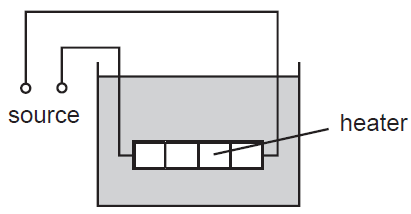Physics 9702 Doubts | Help Page 66
Question 366: [Waves]
Monochromatic plane wave of speed c and wavelength λ is diffracted at small aperture.
Diagram illustrates successive wavefronts.
After what time will some portion of wavefront XY reach point P?
A 3λ / 2c B 2λ / c C 3λ / c D 4λ / c
Reference: Past Exam Paper – June 2012 Paper 12 Q29
Solution 366:
Answer: C.
The distance between the 2 successive lines (wavefronts) is λ. This is for both the straight and curved lines. So, wavefront XY is separated by a distance of 3λ from the wavefront that has reached point P.
Distance that needs to be travelled = 3λ
Speed of light = c
Speed = Distance / Time
Time = distance / speed = 3λ / c
Question 367: [Waves > Diffraction]
(a) State what is meant by diffraction of a wave.
(b) Plane wavefronts are incident on a slit, as shown in Fig.
Complete Fig. to show four
wavefronts that have emerged from the slit.
(c) Monochromatic light is incident normally on diffraction grating
having 650 lines per millimetre, as shown.
An image (the zero order) is
observed for light that has angle of diffraction equal to zero.
For incident light of wavelength 590
nm, determine number of orders of diffracted light that can be observed on each
side of the zero order.
(d) Images in Fig. are viewed, starting with the zero order and then
with increasing order number.
State how appearance of the images
changes as the order number increases.
Reference: Past Exam Paper – November 2010 Paper 21 Q5
Solution 367:
(a) When a wave passes through a slit / by an edge, the wave spreads
out / changes direction.
(b) In the diagram, the wavelength is unchanged (separation lines is same
and equal) and the wavefront is flat at the centre, curving into geometrical
shadow.
(c)
For a diffraction grating,
d sinθ
= nλ
{The angle for the largest
order is 90o.}
For angle of diffraction, θ = 900,
{There are 650 in 1mm (=
0.001m = 10-3m). Slit separation, d = separation between 2
successive lines = 10-3 / 650 = 1 / (650x103) m. Also,
sin 90o = 1.}
1 / (650x103) = n (590x10-9)
n = 2.6
{The number of order can
only be an integer.}
Number of orders that can be
observed is 2
(d) The intensity / brightness decreases (as the order increases).
Question 368: [Current of Electricity > Resistance]
Diagram shows a low-voltage circuit for heating water in a fish tank.
Heater has a resistance of 3.0 Ω. Voltage source has an e.m.f. of 12 V and internal resistance of 1.0 Ω.
At what rate does voltage source supply energy to the heater?
A 27 W B 36 W C 48 W D 64 W
Reference: Past Exam Paper – June 2006 Paper 1 Q34
Solution 368:
Answer: A.
Rate of energy supplied to heater =
Power dissipated by heater
Power P dissipated by = I2R where R is the resistance of the
heater
Total resistance in circuit, RT
= 3.0 + 1.0 = 4.0 Ω
Current I in circuit = V / RT
= 12 / 4.0 = 3.0 A
Power dissipated by heater = I2R
= (3.0)2 (3.0) = 27 W
Question 369: [Current of Electricity]
Four point charges, each of charge Q, are placed on edge of an insulating disc of radius r.
Frequency of rotation of the disc is f.
What is the equivalent electric current at the edge of disc?
A 4Qf B 4Q / f C 8πrQf D 2Qf / πr
Reference: Past Exam Paper – November 2006 Paper 1 Q31
Solution 369:
Answer: A.
Total charge = It where I is the current and t is the time
Total charge on disc = Q + Q + Q + Q = 4Q
Frequency = 1 / Period for 1 rotation
Period t for 1 rotation = 1 / f
Current I = Total charge / time = 4Q / (1/f) = 4Qf







22/O/N/10 Q.2(b)
ReplyDelete23/O/N/10 Q.7(b)(ii)
The second one is explained at
Deletehttp://physics-ref.blogspot.com/2015/02/physics-9702-doubts-help-page-71.html
21/M/J/11 Q.7
ReplyDeleteIt's explained at
Deletehttp://physics-ref.blogspot.com/2015/02/physics-9702-doubts-help-page-68.html
12/M/J/11 Q.34
ReplyDeleteDetails have been added at
Deletehttp://physics-ref.blogspot.com/2014/09/9702-june-2011-paper-12-worked.html
How do we know when to use P=VI or P=I^2R?
ReplyDeleteBasically, both are the same, but we need to apply the formula correctly.
DeleteConsider P = VI
FOr a cell, V is the emf of the cell and I is the total current coming from the cell.
For a resistor, V is the pd across the resistor and I is the current flowing through it.
Consider P = I^2R. it is just V = IR replaced in the equation.
FOr a cell, we do not use this equation since it may not have a resistance. We use the above formula.
For a resistor, I is the current through it and R is its resistance.
In the above question,
DeleteIf we use p=VI after calculating the current using: current I in circuit = V / R = 12 / 4.0 = 3.0 A
P=VI
12*3=36
This gives us an incorrect answer. Is this because the v is supposed to be the potential difference across the resistor and not the EMF?
Of course, that's what I said above
Deletethank u! Your website is very useful!!
ReplyDelete